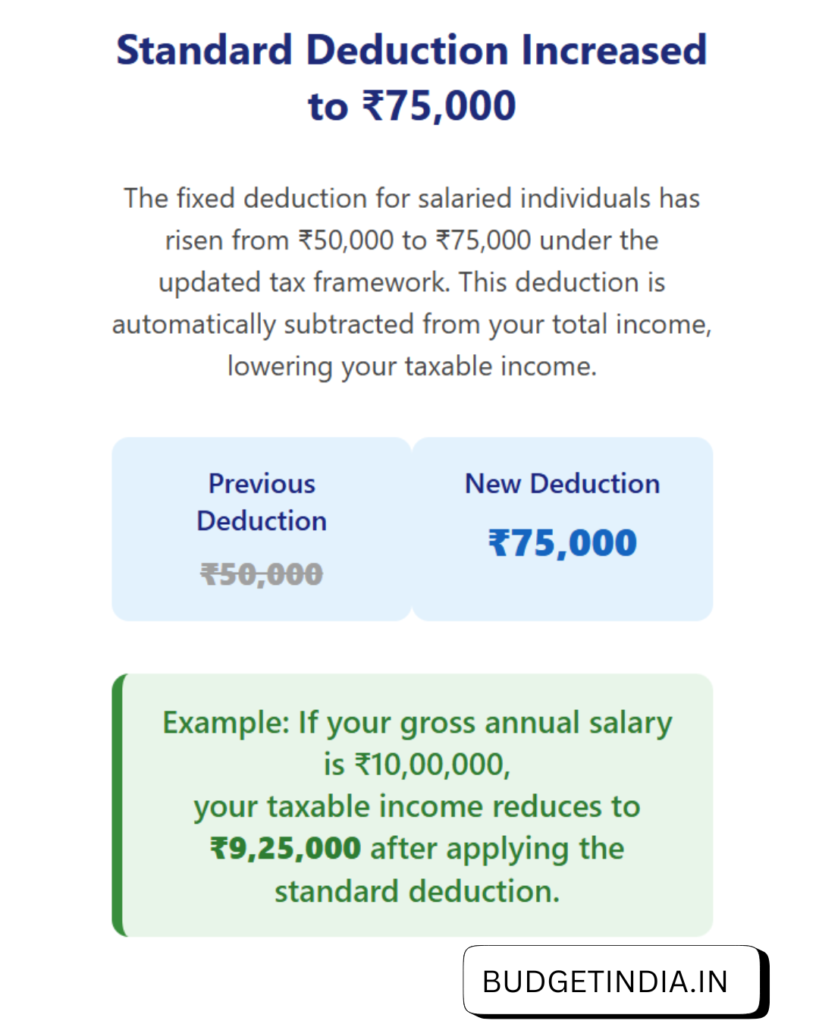In an attempt to match the evolving financial expectations of the workforce, the Union Budget 2025 introduced impactful revisions to the tax system, particularly benefiting those earning a regular monthly income. These modifications focus on greater tax saving, higher take-home pay, long-term savings, and smoother filing processes.
Whether you’re starting your professional career, progressing in your job, or approaching retirement, understanding these updated tax provisions can help you make smarter financial decisions and pick the most rewarding tax framework for Tax saving.
- Overview of Taxation Changes for Employees
- Major Tax Changes for Employees in Budget 2025
- Major Tax Saving Benefits of Budget 2025 for Salary Earners
- Comparing the Previous and New Regimes (2025 Version)
- How to Use the 2025 Tax Reforms Effectively: A Step-by-Step Guide to Maximizing Tax Saving
- Who Should Opt for the New Regime?
- Examples to Understand Practical Impact
- Common Mistakes to Avoid
- Pro Tips to Save More in 2025
- Conclusion
- FAQs (Frequently Asked Questions)
Overview of Taxation Changes for Employees
Tax reforms for salaried professionals are updates in the income tax framework that directly affect individuals earning a fixed salary. These changes may involve revised tax brackets, enhanced deductions, increased exemptions, or new rebates—implemented to ease the tax burden, simplify compliance, and boost financial wellbeing.
In the Union Budget 2025, the government introduced several favorable updates for employees. Highlights include an enhanced standard deduction, a higher rebate threshold, improved National Pension Scheme (NPS) benefits, and a streamlined tax slab structure under the revised regime—designed to offer more value and simplicity to taxpayers.
Major Tax Changes for Employees in Budget 2025
1. Standard Deduction Hiked to ₹75,000
New Development:
The fixed deduction applicable to salaried individuals under the updated tax framework has increased from ₹50,000 to ₹75,000. This deduction is automatically subtracted from total income, reducing the taxable portion.
How It Helps:
No paperwork or investment proof is required, and it brings direct tax relief. Ideal for employees who don’t use other deductions like home loan interest or insurance premiums.
Illustration:
If your gross annual pay is ₹10 lakh, your taxable income drops to ₹9.25 lakh after applying the standard deduction.

2. 14% Employer Contribution to NPS Now Tax-Free for Private Sector Too
Earlier Rule:
Government staff could claim tax exemption on up to 14% of their employer’s NPS contribution, while private sector workers were limited to 10%.
Current Revision:
Now, private employees can also enjoy a 14% employer NPS contribution exemption under Section 80CCD(2).
Why It’s Useful:
- Strengthens retirement savings
- Reduces taxable salary
- Promotes NPS as a preferred retirement tool
Example:
If your basic salary is ₹50,000 per month and your employer contributes 14% to NPS (₹7,000), you get an annual tax-free benefit of ₹84,000.
3. New Tax Slabs for FY 2025–26 Under the Revised Tax System: Unlocking Greater Tax Saving
The government has proposed a more rational and progressive tax slab model under the restructured regime:
| Annual Income | Applicable Tax Rate |
|---|---|
| Up to ₹4,00,000 | 0% |
| ₹4,00,001 – ₹8,00,000 | 5% |
| ₹8,00,001 – ₹12,00,000 | 10% |
| ₹12,00,001 – ₹16,00,000 | 15% |
| ₹16,00,001 – ₹20,00,000 | 20% |
| ₹20,00,001 – ₹24,00,000 | 25% |
| Over ₹24,00,000 | 30% |
Benefits:
- Smooth transition between tax brackets
- Greater savings for middle-income professionals
- Easier to compute and plan taxes
Example:
For a person with ₹12.5 lakh in income, tax is calculated progressively starting beyond ₹4 lakh, resulting in an overall lower tax impact.
4. Rebate Under Section 87A Increased to ₹60,000
What It Means:
This rebate helps reduce your final tax amount.
Budget Update:
- Earlier rebate: ₹25,000 for income up to ₹7 lakh
- New rebate: ₹60,000 for those earning up to ₹12 lakh
Effective Outcome:
When combined with the ₹75,000 standard deduction, individuals with income up to ₹12.75 lakh may end up with no tax liability.
Major Tax Saving Benefits of Budget 2025 for Salary Earners
| Feature | Tax Relief Advantage |
|---|---|
| ₹75,000 Standard Deduction | Cuts taxable earnings with ease |
| 14% NPS Employer Contribution | Higher tax-free retirement savings |
| ₹60,000 Section 87A Rebate | Nil tax up to ₹12.75 lakh income |
| Simplified Tax Brackets | Transparent and fair taxation |
| No Documentation Required | Streamlined process for taxpayers |
Comparing the Previous and New Regimes (2025 Version)
| Parameter | Old Framework | Revised System (FY 2025–26) |
|---|---|---|
| Standard Deduction | ₹50,000 | ₹75,000 |
| Section 80C Benefits | Permitted | Not applicable |
| Employer NPS Deduction | Max 10% | Now 14% |
| Section 87A Rebate | ₹12,500 (for income ≤ ₹5L) | ₹60,000 (for income ≤ ₹12L) |
| Complexity Level | Higher | Lower, user-friendly |
How to Use the 2025 Tax Reforms Effectively: A Step-by-Step Guide to Maximizing Tax Saving
- Review Your Salary Components
Understand your pay breakup including basic, allowances, and perks to plan tax savings better. - Compare Regimes Using Tax Tools
Use income tax comparison calculators to determine which regime offers better savings for your specific profile. - Communicate Regime Choice to Your Employer
Declare your tax regime preference early in the financial year (preferably April) to ensure accurate TDS. - Track NPS Employer Contributions
Ensure your 14% NPS contribution shows in your Form 16 and gets claimed under Section 80CCD(2). - Select the Correct ITR Form
Most salaried individuals can use ITR-1 or ITR-2. Always verify your Form 26AS to avoid errors.
Who Should Opt for the New Regime?
Best For:
- Individuals not claiming deductions under 80C, 80D, etc.
- Fresh professionals or early-career employees
- Salaried earners in the ₹5 lakh–₹15 lakh range
- Those not paying rent (living with parents/own house)
Not Ideal For:
- Taxpayers with large 80C investments or loan-related deductions
- Those with home loans claiming interest deductions
- Employees using HRA or other allowances under the old regime
Examples to Understand Practical Impact
Example 1: Income = ₹10 Lakh
- Deduction: ₹75,000 standard
- Net taxable = ₹9.25 lakh
- Tax = ₹26,250
- Rebate of ₹60,000 nullifies it → Zero tax payable
Example 2: Income = ₹15 Lakh
- Deduction: ₹75,000 standard + ₹84,000 employer NPS
- Taxable = ₹13.41 lakh
- Approximate tax: ₹1.11 lakh
Common Mistakes to Avoid
- Forgetting to declare your tax regime to the employer
- Expecting old deductions to work under the new setup
- Ignoring income from savings or FDs while filing returns
- Overlooking mismatch between Form 16 and Form 26AS
Pro Tips to Save More in 2025
- Evaluate both regimes annually based on your income and investments
- Avoid mixing deductions from both systems
- Use the 14% NPS benefit to its fullest
- Submit Form 10IEA while filing if switching to the new regime
Conclusion
The Union Budget 2025 marks a turning point for salaried taxpayers in India by focusing on simplicity, clarity, and substantial savings. With features like a higher standard deduction, wider rebate eligibility, and more user-friendly slabs, the revamped tax regime serves as a practical choice for many.
Choosing the best regime hinges on your income level, deductions claimed, and overall financial goals. With proper understanding and early planning, these reforms can pave the way for better savings and improved financial discipline.
FAQs (Frequently Asked Questions)
1. What is the updated standard deduction?
₹75,000 is the new fixed deduction for salaried taxpayers under the revised regime.
2. Can private sector employees claim the 14% NPS contribution?
Yes, this is now extended to private employees as well.
3. What income level is entirely tax-free under the new rules?
Incomes up to ₹12.75 lakh (including deductions and rebate) may attract zero tax.
4. Which regime should I choose?
If you don’t have many deductions to claim, the new system will likely be more beneficial.
5. Is any form required to choose the new regime?
Yes. Inform your employer or submit Form 10IEA while filing your return.
6. Do these reforms apply under the old system?
No, all major updates like the higher rebate and deduction are part of the new tax regime only.
7. When should I declare my tax regime preference?
At the start of the financial year to ensure correct TDS deduction.






Leave a Reply